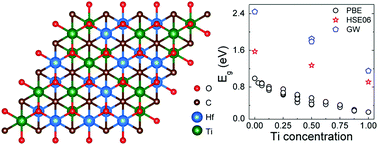Prediction of MXene based 2D tunable band gap semiconductors: GW quasiparticle calculations
Abstract
MXenes are a large family of layered transition metal carbide/nitride materials that possess a number of desired properties such as flexible chemical composition, high mechanical strength, and excellent structural stability. Although MXene based semiconductors have attracted considerable recent research attention in the search of novel 2D electronic materials, accurate understanding of their electronic properties has not been established. In this work, we carry out fully converged GW quasiparticle calculations for M2CO2 (M = Hf, Zr, and Ti) MXene based 2D semiconductors and alloys using newly developed accelerated GW methods. The quasiparticle band gaps of single-layer Hf2CO2, Zr2CO2, and Ti2CO2 are predicted to be 2.45, 2.13, and 1.15 eV, respectively. The narrow band gap of Ti2CO2 is attributed to the low energy of Ti 3d as compared with the Hf and Zr d states. Considering their chemical similarity, it is expected that Hf2−2xTi2xCO2 semiconductors can be synthesized without difficulties. We show that the quasiparticle band gap of Hf2−2xTi2xCO2 (0 ≤ x ≤ 1) semiconductor alloy can be continuously tuned from 2.45 to 1.15 eV, offering a unique 2D semiconductor with a moderate and tunable gap for future electronics applications.



 Please wait while we load your content...
Please wait while we load your content...